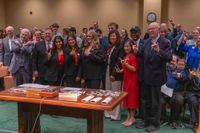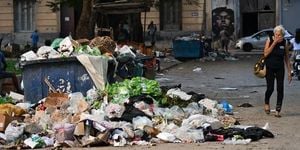Across the United States, colleges and universities are grappling with a dramatic decline in international student enrollment—a shift that’s sending shockwaves through both campus communities and local economies. According to NAFSA’s analysis, as reported by EIN Presswire and Bridge Michigan, U.S. universities may see up to 150,000 fewer international students this fall, marking a 15% drop in overall enrollment and an estimated $7 billion loss in revenue nationwide. In Michigan alone, that translates to nearly $230 million lost, a figure that underscores just how deeply these changes are being felt.
The causes of this enrollment crisis are multifaceted, but recent federal policy changes stand out as a key driver. Since the Trump administration took office, a series of executive orders and regulatory shifts have made it harder for international students to come—or even stay—in the U.S. The administration’s travel ban on 19 countries, heightened scrutiny of visa applications (including new requirements to vet applicants’ social media), and the abrupt shutdown of key U.S. embassies overseas have all contributed to long delays, limited interview appointments, and stricter scrutiny for would-be students. As Bridge Michigan notes, the State Department revoked over 6,000 student visas in 2025 alone, citing visa overstays or legal violations.
For many students, these obstacles have proven insurmountable. Jennifer DeHaemers, vice president of student recruitment and retention at Central Michigan University (CMU), told Bridge Michigan, “They are just getting a higher level of scrutiny beyond, ‘What are you planning to study, at what institution and are you planning to come home?’” The impact at CMU is stark: international student enrollment is expected to drop by about 400 students, or 70%, compared to last year. “That’s a pretty big decrease in the number of students we would be expecting to show up,” DeHaemers said.
Beyond the personal stories of students, the economic repercussions are severe. International students typically pay up to three times as much in tuition as their domestic peers, and their spending on housing, food, and entertainment is a vital part of local economies. “Our international students make the experience here more rich because they share their culture with us, they tend to be good students and … they add to the economic development in the country. It will be a big loss in a number of different ways,” DeHaemers added. The loss isn’t just financial; it’s cultural, too. Interim Chancellor Gabriella Scarlatta of U-M Dearborn, herself a former international student, emphasized, “Our campus is not going to be as rich without international students … who bring a wealth of culture to our students.”
Institutions across the country are feeling this squeeze. The University of Nebraska system, for example, reported a slight 0.2% decline in enrollment this fall—a loss of 111 students—with much of the decrease attributed to 174 fewer international students and 238 fewer graduate students, according to Nebraska Examiner. While the total fall enrollment stood at 49,648, the system faces a $20 million budget shortfall by year’s end. Some campuses, such as the University of Nebraska-Lincoln, are finalizing plans to cut more than $40 million in the coming months, including a 5% tuition increase approved in June.
Despite these headwinds, there are glimmers of resilience. The Nebraska College of Technical Agriculture saw an uptick in students thanks to a new online veterinary technician program, and the University of Nebraska Medical Center recorded a 2.4% increase in enrollment. NU President Jeffrey Gold pointed to changing student demographics and the need for more flexible, individualized support, highlighting credit-sharing agreements with community colleges and a push for more online programs. “These enrollment numbers show that we are subject to the national trends but continue to serve Nebraskans well,” Gold said. He added, “Like institutions nationwide, we continue to face headwinds with graduate and international enrollment, and there is important work ahead to ensure that we continue to grow enrollment, support workforce demands across a wide range of Nebraska industries and fuel the future of our state.”
Other universities are attempting to stem the losses by working with international students to start their studies online or defer enrollment until January 2026. At U-M Dearborn, for instance, new international students are being supported until they can obtain visas, potentially by next semester. But these are temporary fixes to a deeper problem—one that is as much about perception as policy. As Oakland University President Ora Pescovitz told Bridge Michigan, “The attack on international students has made it very unwelcoming for people to come.”
For families navigating this tumultuous landscape, organizations like InAmerica Education have become vital lifelines. Founded in 2013, InAmerica specializes in personalized educational consulting, helping families and students overcome the maze of admissions hurdles and visa obstacles. Their approach includes tailored admissions strategies, exploring schools with flexible deferral options, identifying alternative pathways, and managing paperwork with precision. But what sets them apart, according to EIN Presswire, is their focus on authentic storytelling—helping students express their values, experiences, and resilience in ways that resonate with increasingly selective admissions committees.
“Each student’s admissions strategy is tailored to align with individual strengths and the realities of the current landscape—whether that involves exploring schools with flexible deferral options, identifying alternative pathways, or ensuring paperwork and timelines are managed with precision,” InAmerica’s team explains. The goal is to ensure students not only overcome today’s obstacles but also shine as future leaders prepared to thrive in whatever comes next.
The stakes are high. U.S. universities have long been considered global leaders in higher education, attracting talent from around the world. As Rachel Banks of NAFSA told Bridge Michigan, “If this continues, then it raises some really serious concerns about the ability for (American) colleges and universities to remain the top universities in the world.” The current crisis threatens not only institutional budgets and local economies but also the diversity and vibrancy that international students bring to American campuses.
As the fall semester unfolds, it’s clear that the landscape of higher education is changing—and fast. Institutions are scrambling to adapt, students are making difficult choices, and consultants are working overtime to guide families through the storm. Whether these efforts will be enough to preserve the U.S.’s status as a global education powerhouse remains to be seen. But for now, the message from campuses across the country is unmistakable: the loss of international students is being felt in classrooms, communities, and balance sheets alike.
In the midst of uncertainty, one thing is certain—higher education’s future will depend on how well it can adapt to a world where old assumptions no longer hold, and where welcoming the world’s students is no longer a given, but a challenge to be met head-on.




